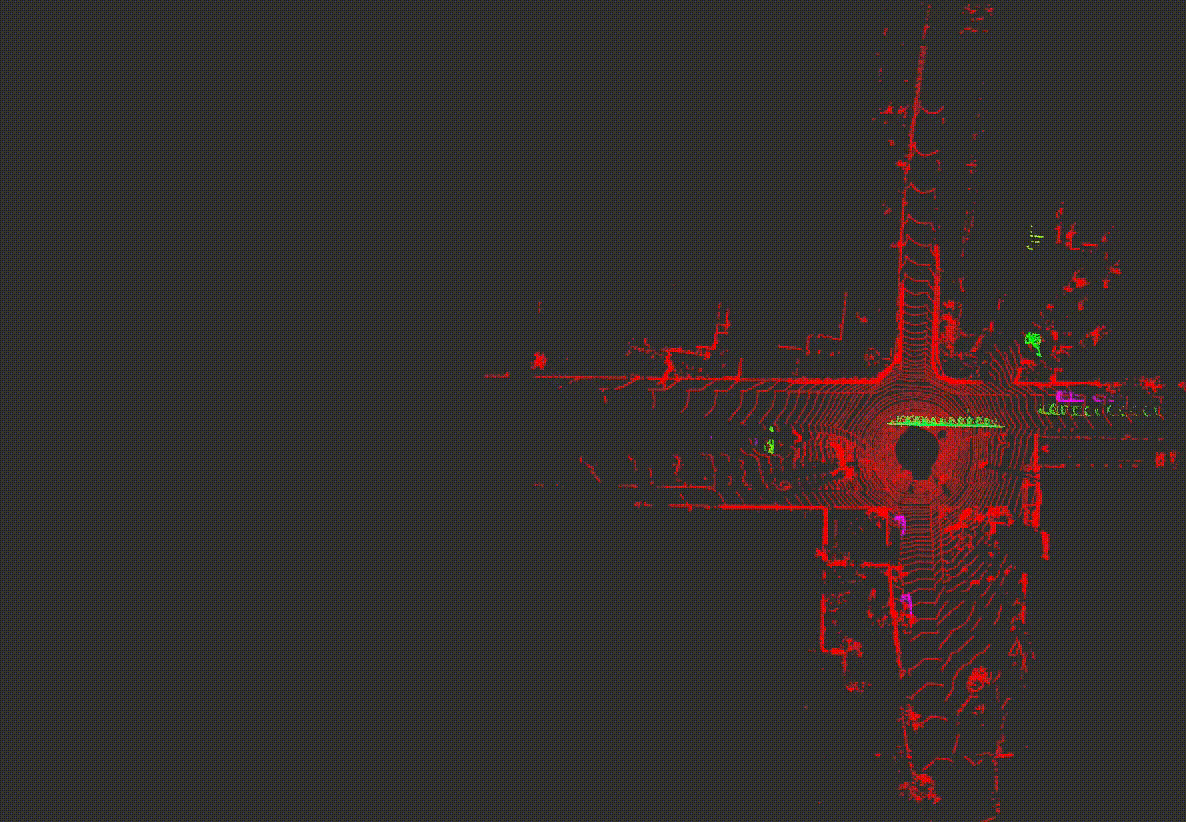Official page of "ERASOR: Egocentric Ratio of Pseudo Occupancy-based Dynamic Object Removal for Static 3D Point Cloud Map Building", which is accepted by RA-L with ICRA'21 option [Demo Video].
We provide all contents including
- Source code of ERASOR
- All outputs of the State-of-the-arts
- Visualization
- Calculation code of Preservation Rate/Rejection Rate
So enjoy our codes! :)
(PLEASE REMIND THAT THIS REPO IS IN PROGRESS!! ERASOR is operated well, but other utility files may be completed by ~6/6)
So,
Contact: Hyungtae Lim (shapelim@kaist.ac.kr)
Advisor: Hyun Myung (hmyung@kaist.ac.kr)
- Test Env.
- Requirements
- How to Run ERASOR
- Calculate PR/RR
- Benchmark
- Run Your Own Code
- Visualization of All the State-of-the-arts
- Citation
The code is tested successfully at
- Linux 18.04 LTS
- ROS Melodic
- Install ROS on a machine.
- Also, jsk-visualization is required to visualize Scan Ratio Test (SRT) status.
sudo apt-get install ros-melodic-jsk-recognition
sudo apt-get install ros-melodic-jsk-common-msgs
sudo apt-get install ros-melodic-jsk-rviz-plugins- Thereafter, compile this package. We use catkin tools,
mkdir -p ~/catkin_ws/src
cd ~/catkin_ws/src
git clone https://github.com/LimHyungTae/ERASOR.Official.git
cd .. && catkin build erasor - Our metric calculation for PR/RR code is implemented by python2.7
- To run the python code, following pakages are necessary: pypcd, tqdm, scikit-learn, and tabulate
pip install pypcd
pip install tqdm
pip install scikit-learn
pip install tabulate- Download the preprocessed KITTI data encoded into rosbag.
- The downloading process might take five minutes or so. All rosbags requires total 2.3G of storage space
wget https://urserver.kaist.ac.kr/publicdata/erasor/rosbag/00_4390_to_4530_w_interval_2_node.bag
wget https://urserver.kaist.ac.kr/publicdata/erasor/rosbag/01_150_to_250_w_interval_1_node.bag
wget https://urserver.kaist.ac.kr/publicdata/erasor/rosbag/02_860_to_950_w_interval_2_node.bag
wget https://urserver.kaist.ac.kr/publicdata/erasor/rosbag/05_2350_to_2670_w_interval_2_node.bag
wget https://urserver.kaist.ac.kr/publicdata/erasor/rosbag/07_630_to_820_w_interval_2_node.bag- Please note that the rosbag consists of
node. Refer tomsg/node.msg. - Note that each label of the point is assigned in
intensityfor the sake of convenience. - And we set the following classes are dynamic classes:
# 252: "moving-car"
# 253: "moving-bicyclist"
# 254: "moving-person"
# 255: "moving-motorcyclist"
# 256: "moving-on-rails"
# 257: "moving-bus"
# 258: "moving-truck"
# 259: "moving-other-vehicle"
- Please refer to
std::vector<int> DYNAMIC_CLASSESin our code :).
We will explain how to run our code on seq 05 of the KITTI dataset as an example.
Step 1. Build naive map
- Set the following parameters in
launch/mapgen.launch.target_rosbag: The name of target rosbag, e.g.05_2350_to_2670_w_interval_2_node.bagsave_path: The path where the naively accumulated map is saved.
- Launch mapgen.launch and play corresponding rosbag on the other bash as follows:
roscore # (Optional)
roslaunch erasor mapgen.launch
rosbag play 05_2350_to_2670_w_interval_2_node.bag- Then, dense map and voxelized map are auto-saved at the
save path. Note that the dense map is used to fill corresponding labels (:warning: To be explained). The voxelized map will be an input of step 2 as a naively accumulated map.
-
Set the following parameters in
config/seq_05.yaml.initial_map_path: The path of naively accumulated mapsave_path: The path where the filtered static map is saved.
-
Run the following command for each bash.
roscore # (Optional)
roslaunch erasor run_erasor.launch target_seq:="05"
rosbag play 05_2350_to_2672_w_interval_2_node.bag- IMPORTANT: After finishing running ERASOR, run the following command to save the static map as a pcd file on another bash.
- "0.2" denotes voxelization size.
rostopic pub /saveflag std_msgs/Float32 "data: 0.2"- The results will be saved under the
save_pathfolder, i.e.$save_path$/05_result.pcd.
python analysis.py-
Error metrics are a little bit different from those in the paper:
Seq. PR [%] RR [%] 00 91.72 97.00 01 91.93 94.63 02 81.08 99.11 05 86.98 97.88 07 92.00 98.33 -
But we provide all pcd files! Don't worry. See Visualization of All the State-of-the-arts Section.
- First, download all pcd materials.
wget https://urserver.kaist.ac.kr/publicdata/erasor/erasor_paper_pcds.zip
unzip erasor_paper_pcds.zip-
Set parameters in
config/viz_params.yamlcorrectlyabs_dir: The absolute directory of pcd directoryseq: Target sequence (00, 01, 02, 05, or 07)
-
After setting the parameters, launch following command:
roslaunch erasor compare_results.launch- Then you can inspect all pcd results that are already parsed into static points and dynamic points.
- All examples are here:
If you use our code or method in your work, please consider citing the following:
@article{lim2021erasor,
title={ERASOR: Egocentric Ratio of Pseudo Occupancy-Based Dynamic Object Removal for Static 3D Point Cloud Map Building},
author={Lim, Hyungtae and Hwang, Sungwon and Myung, Hyun},
journal={IEEE Robotics and Automation Letters},
volume={6},
number={2},
pages={2272--2279},
year={2021},
publisher={IEEE}
}


